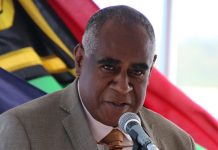By Makereta Komai, PACNEWS Editor in Nadi
The government of Cook Islands undertook five years of exhaustive consultation throughout the islands before it set up its marine park, the Moana Marae in 2017.
In the five years – from 2011-2016, it conducted 34 public meetings, sent out 212 questionnaire surveys, convened five stakeholder workshops and set up 32 committees and taskforce meetings.
Marae Moana is a multi-use marine park which extends over the entire Exclusive Economic Zone (EEZ) of Cook Islands, an area of 1.9 million square kilometres. It is currently the largest commitment by a Pacific country for integrated management and conservation from ridge to reef and reef to the ocean.
At the regional ocean governance dialogue in Nadi this week, Cook Islands Seabed Minerals Commissioner, Alex Herman shared her island’s experiences in the development of the marine park – set up to protect and conserve the ecological, biodiversity and heritage values of marine environment.
In July 2017 the Marae Moana Act was passed by the Cook Islands Parliament under the leadership of the former Prime Minister Henry Puna, the current Secretary General of the Pacific Islands Forum.
Cook Islands EEZ of 2 million square kilometres is one of the largest in the Pacific – seven times New Zealand’s land mass and 1,039 times bigger than Fiji’s land mass, said Herman.
It’s 15 islands represent 0.01 percent of its EEZ. So Cook Islands 99.99 percent ocean, added Herman.
Around each of the 15 islands is a marine protected area extending 50 nautical miles from each island and encircling the island. The marine protected areas prohibit large-scale commercial fishing and seabed minerals activities.
She said one of the successes of the Marae Moana is the broad stakeholder buy-in from all the stakeholders greater public awareness.
“From the public consultation, a lot of the people wanted the island country’s EEZ to be declared a marine park. It was whole of society approach where there was enhanced co-operation, unity and co-operation amongst stakeholders including technical agencies.
Following enactment of the Marae Moana Act 2017, a comprehensive action plan was developed that includes all relevant government agencies, NGOs and traditional leaders. The action plan is based on agency and organisation business plans to demonstrate what is being done towards achieving the Marae Moana policy objectives. Following this, a capacity needs assessment will be done to determine the challenges encountered by agencies and organisations and this will help determine investment needed for the successful implementation of the Marae Moana policy.
Members of the Marae Moana Council and Technical Advisory Group have been confirmed and appointed, rules and procedures have been developed and regular meetings of the two groups held. The Technical Advisory Group is currently putting together marine spatial planning procedures to help with the development of the National Marae Moana Spatial Plan – a marine spatial plan that covers the entire Cook Islands Exclusive Economic Zone. The Cook Islands is seeking help with the collection of deep ocean biodiversity data (up to 6,000 metres deep) for that marine spatial plan.
SOURCE: PACNEWS














